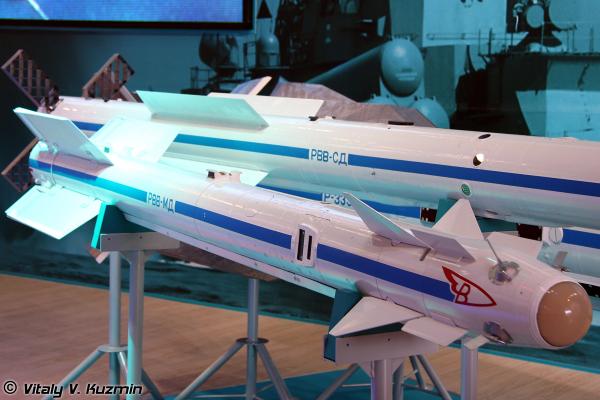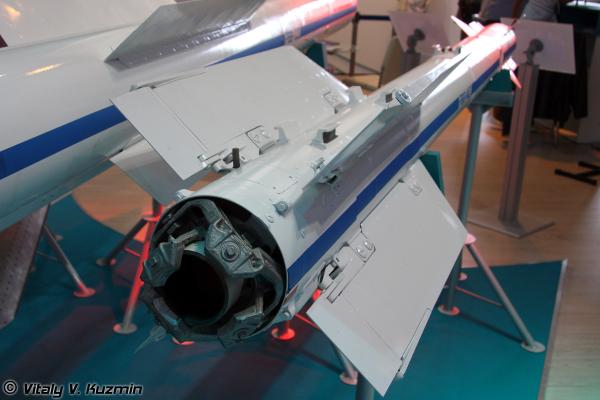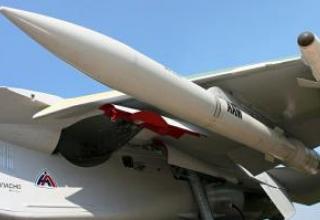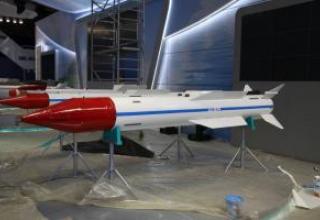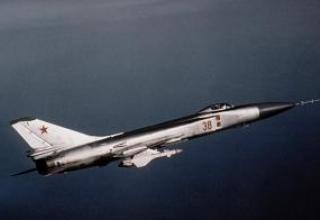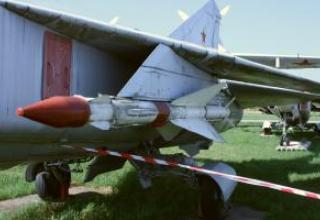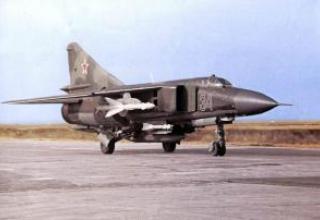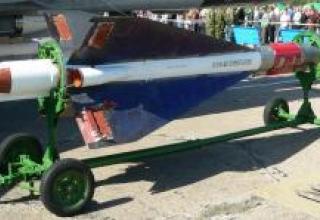Air-to-air guided missile of the Airborne-MD class of short range is designed to conduct close highly maneuverable air combat, ensures the defeat of air targets (fighters, attack aircraft, bombers, BTA aircraft and helicopters) at any time of the day, from any direction, on the background of the ground, with active counteraction of the enemy. The missile has increased noise immunity, including optical interference. It is designed for armament of fighters, attack aircraft and attack helicopters.
Designed and manufactured by JSC GosKB Vympel named after I.I. Toropov (part of the Tactical Missile Arms Corporation - KTRV). The RVV-MD is a further development of the R-73 missile of the same class.
Layout of the missile was first demonstrated at the international exhibition MAKS-2009, testing began in late 2012. During the MAKS-2015 exhibition, Boris Obnosov, head of KTRV, said that mass production of new missiles will be launched by the end of 2015.
Composition:
The aerodynamic scheme, layout and overall dimensions of the missile are identical to the basic model.
On the outer surface of the hull there are four groups of X-shaped planes. Immediately behind the head fairing are four sensors of aerodynamic angles, with which the automatics monitor the parameters of the missile's flight. Behind them there is a group of trapezoidal stabilizers, behind which there is a 385 mm boom-shaped all-terrain aerodynamic rudders. The tail part of the hull is equipped with trapezoidal wings with ailerons. When the engine is running, the control and stabilization of the rocket on the pitch and course is carried out jointly connected in pairs for each channel four aerodynamic rudders and four gas-dynamic interceptors. After the engine is running, only the aerodynamic rudders control and stabilization. The stabilization of the rocket on the heel is carried out using four mechanically connected ailerons.
The gas-dynamic device makes it possible to control the thrust vector of the propulsion system. Combined aerodynamic control provides high maneuverability and the possibility of hitting targets maneuvering with overloads up to 12g.
The missile guidance system includes a dual-band infrared homing head with target designation angles of up to ±60°, providing all-around homing to the front (LPS) and rear hemisphere (RH). The RVV-MD missile is highly noise-proof against optical interference, which ensures its effective use in difficult conditions, including ground conditions, from any direction and when the enemy is actively using countermeasures. The maximum range of the missile in the ABI is 40 km.
The propulsion system is a single-mode RDTT. Battle unit - rod type. Explosive device - laser non-contact target sensor (for RVV-MDL modification), radar non-contact target sensor (for RVV-MD).
Installation of the rocket on the aircraft carrier, as well as providing power in flight on the suspension, combat launch and emergency drop is carried out with the help of rail aircraft launcher P-72-1D (P-72-1BD2) (type P-72). The device (see photo) is an autonomous system containing all the necessary equipment for preparing and launching the missile, and is made in the form of a special beam, which is attached to the aircraft suspension units. RCE provides the missile with the necessary voltages of various signs and denominations, generates and issues commands on the missile preparation for launch and launch, electromechanical lock holds the missile in the guides of the launch device, fills the homing head with high nitrogen pressure. Overall dimensions of the automatic control unit P-72-1D (P-72-1BD2): length - 2600 mm, width - 108 mm, height - 215 mm. Weight - 49 kg.
Suspension of rockets RVV-MD with the aviation starting device (by means of a pylon-adapter) on aircraft of foreign manufacture is possible.
Characteristics:
| Launch range, km : - minimum at CSW - PPP maximum |
0.3 up to 40 |
| Angles of target designation, deg | ± 60 |
| Deviation angles of the CLO coordinator, deg. | ± 75 |
| Height of targets, km | 0,02 - 20 |
| Overload of affected targets, g | up to 12 |
| Range of gripping the IGS target of the fighter type in the CPS, the engine in the "maximum" mode, q=15°, at medium altitudes, km | 10 |
| Operation time of the cooling system in continuous ready mode from a standard cylinder (7.3 l, hour) | 6 |
| Starter weight, kg | 106 |
| Weight of combat unit, kg | 8 |
| Type of combat unit | pivot |
| Motor unit | single-mode RDTT |
| Dimensions, uh..: - length - case diameter - wingspan - steering wheel range |
2920 170 510 385 |
Testing:
In October-November 2013 at the range of the Russian Ministry of Defense Kapustin Yar were tested version of the "Tor-M2KM" SAM system on the chassis of the Indian company Tata Motors. In the course of tests all the declared tactical and technical characteristics were fully confirmed, in particular, the combat capabilities of the complex to engage air targets at the far border of the kill zone of 15 km, targets flying at a speed of 700 m / s, as well as targets flying with a heading parameter of more than 6 km at a range of 12 km.
All-weather, all-weather and driving characteristics of the complex were confirmed. In addition, in the process of testing was tested interaction in a group consisting of a combat module, transport and charging module 9T244K, radar duty mode "Casta-2E2" and a unified battery command post "Ranzhir-MK".
Sources:
- http://www.ktrv.ru/production/68/649/901/
- http://vitalykuzmin.net/
- Авиационное пусковое устройство П-72-1Д (П-72-1Д1, П-72-1ДБ2)
- Авиационное пусковое устройство АПУ-73-1Д (П-72-1Д)
- ОАО "КТРВ" представляет на МАКС-2009 новые образцы ракетного вооружения
- АВИАЦИОННАЯ УПРАВЛЯЕМАЯ РАКЕТА КЛАССА "ВОЗДУХ-ВОЗДУХ" РВВ-МД. Рекламный листок. ОТКРЫТОЕ АКЦИОНЕРНОЕ ОБЩЕСТВО "ГОСУДАРСТВЕННОЕ МАШИНОСТРОИТЕЛЬНОЕ КОНСТРУКТОРСКОЕ БЮРО "ВЫМПЕЛ" ИМЕНИ И.И. ТОРОПОВА. Первая половина второго десятилетия ХХI века. Материал предоставлен Гуровым С.В. (Россия, Город-Герой Тула).
